As you guys know, I recently had the opportunity to spend a couple of months working with the Henry Big Boy Steel Carbine. This gun is heavily advertised as a hunting rifle, but I couldn’t overlook the self/home/farm-defense potential of this handy little carbine. Today I want to share just a few thoughts about using the Henry Big Boy Steel Carbine as a self-defense tool. I’m going to meander over some general lever-gun stuff, as well as some specifics of the Henry. If you’re interested in my full review of the carbine itself, you can check it out here.
The Carbine vs. ‘Real’ Rifles
I don’t want this entire piece to be as a revolver-caliber-carbine versus “real” rifle (or “real” carbine, as the case may be) debate. However, I am going to frame it that way intially. When we get to the end I’m going to bring it all back around in and put it into perspective, but first, let’s address the “power” elephant in the room. I’m going to summon forth Colonel Cooper here, but only to disagree with him (sacrilege, I know†). The Colonel said, in a 1966 Guns & Ammo article entitled “The Carbine Compromise,” that “. . .if you are going to a two-hand weapon you ought to get two-hand ballistics along with it.”
The revolver-caliber carbine does not offer “two-hand” ballistics. Centerfire rifle calibers handily exceed the range and wounding potential of the . 357 Magnum, but this is not the root of my disagreement with the Colonel. Instead, I don’t believe that caliber – with which Col. Cooper might have rightly been accused of being obsessed – is the sole benefit of a two-handed gun. Some others that come to mind are increased hit potential, increased range over a handgun, and negligible recoil. Admittedly the last one is not something the Colonel considered an acceptable reason for choosing ones armament, nor is it the last item upon which he and I disagree (I still pronounce it car-bean).
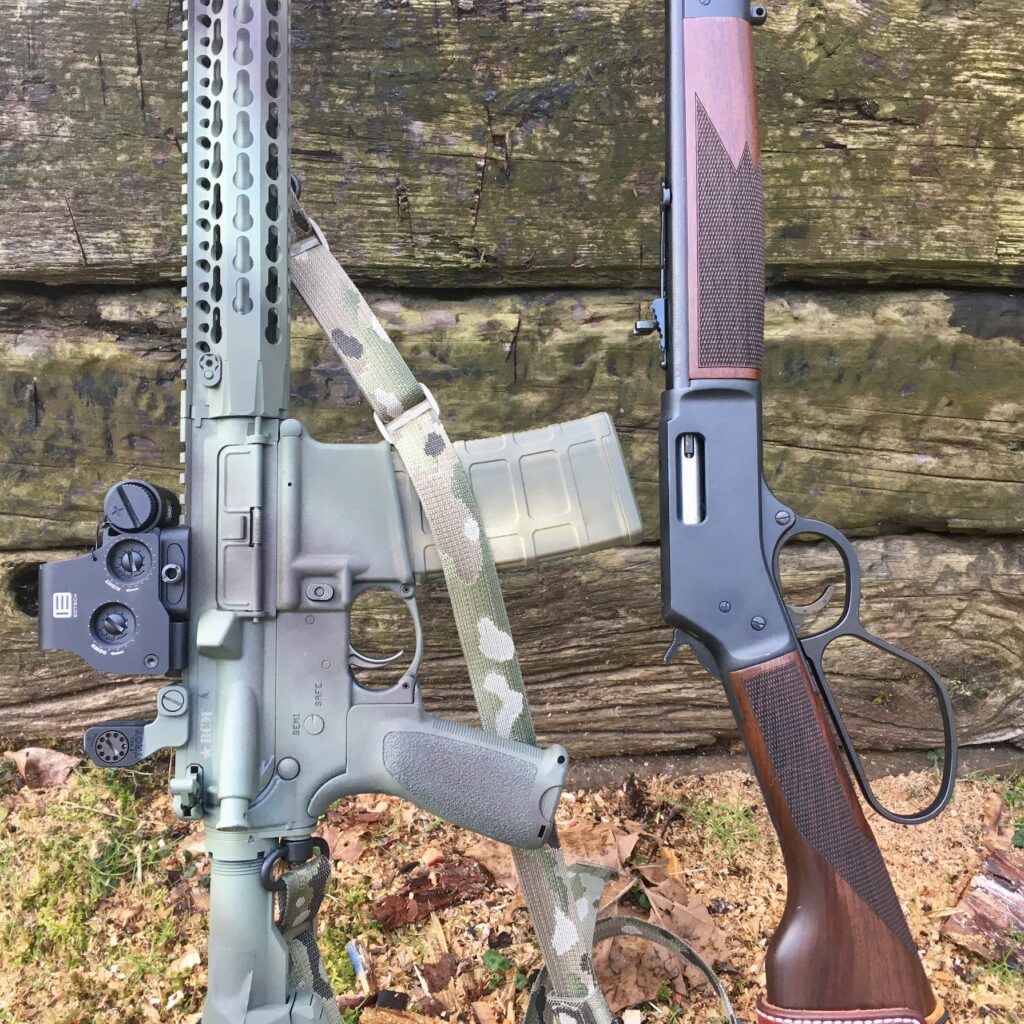
I will admit nit-picking Col. Cooper’s arguments just a bit. However, let’s look at the spirit of the argument as it applies here: does the lever-action carbine give us two-handed benefit? As with every other choice in the world, it does have some benefits but you’ll also make a few compromises.
Two-Handed Benefit?
Let’s talk about caliber briefly. The .357 Magnum is a handgun cartridge. As such, it is imbued with no special powers that elevate it significantly above any other handgun cartridge, despite lore to the contrary. Handgun cartridges, including the .357 Magnum, are all pretty much under-powered for the task of stopping people from doing things they are set on doing. The .357 Magnum from the carbine might be a slightly different story. Maybe for the reasons you’re expecting, and maybe not.
Probably the most important reason is that you’re far more likely to actually hit with the carbine than you are with a handgun. Handguns are notoriously difficult to shoot well (even the easy ones). Instinctively you might recoil from that statement, but consider either how many hours you’ve spent training, or how poorly you shoot a handgun. One of the two is almost certainly true – I don’t know very many people without training and practice that shoot handguns very well. I do know people without training that shoot rifles reasonably well, though. I’m not recommending your avoid training (quite the opposite!), just making the point that “a two-handed weapon” is easier to shoot accurately than a handgun.
As it pertains to the Henry Big Boy Steel Carbine specifically: it is one easy-shouldering gun. It just seems to always come up on target. With one’s thumb resting on the hammer it can be brought to bear with a first shot that is not really any slower than any other long-arm, including the AR. Do we have two-handed benefits in the accuracy and handling departments? Affirmative.
Then there is the “power” issue. Two-thousand two-hundred feet per second (2,200 FPS) is the oft-cited velocity at which bullets start to damage tissues that they have not actually touched. I haven’t gotten that velocity with any of the loads I’ve fired, but some ammunition – like the Buffalo Bore 125-grain JHP – does flirt with it. I don’t know what that means in regards to terminal ballistics. I really want to believe that extra 500 or 600 or 700 FPS will make a meaningful difference, but science tells me it probably won’t make much of one. I think the difference it will make is in ensuring bullets penetrate deeply enough to strike critical organs, vessels, and mechanical structures, and expand.
Bullet selection seems pretty important to me in a lever-action carbine. Most .357 Magnum rounds are designed for handgun velocities. As we saw in the last part of this article, the carbine blows handgun velocities out of the water by 35 to over 50% in my limited testing. A bullet that expands well out of a revolver may completely disintegrate from a carbine. Again, the Buffalo Bore 125-grain JHP seems like an ideal carbine candidate with excellent expansion and penetration. Do we get two-handed benefit in bullet performance? Negative.
Capacity & Reloading
Since we don’t have “two-handed ballistics” in a revolver-caliber carbine, we will probably have to count on shooting an aggressor more than once, and maybe several times. Here we begin to think about capacity. One man’s “just right” is another man’s “dangerously few” and yet another’s “what are ya tryin’ to do? Start a war?” so there’s a massive amount of subjectivity here. But let’s talk about it a little bit anyway.
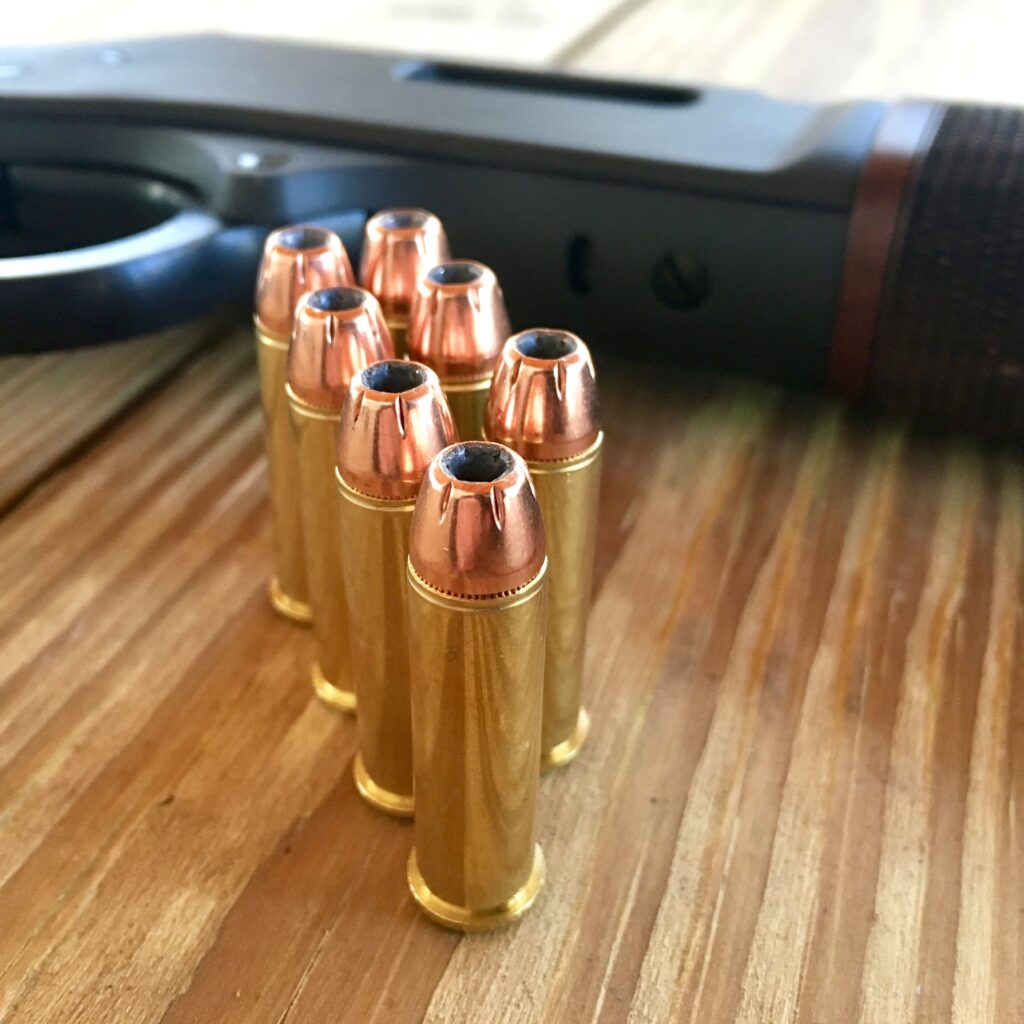
I’ll give you my prejudices right up front: I think eight rounds (7+1) of .357 Magnum will probably solve any “gun problem” I am likely to encounter for the rest of my life. Still, this is a “low capacity” firearm by any measure, with only two more than the revolver’s traditional six, and one more than a lot of newer, full-sized revolvers. Do we get two-handed benefit in the capacity department? Nay, not when compared with modern defensive rifles and carbines.
Again, even though I believe eight likely to be enough, I wanted to truly understand reloads with a rifle of this design. The first decision to be made was how to carry ammo.
Ammunition Carriage
I have found that DeSantis’s 2x2x2 pouch works really well for reloading the magazine tube. This pouch carries on your belt and holds six rounds of .357 or .44 ammunition. I’m sure you could have one made for the various other revolver calibers, as well. Unfortunately the 2x2x2 only holds six rounds, but outside of a bandolier I’m not sure how many rounds you’re going to be able to carry at the ready anyhow.

I also had the opportunity to work with a butt cuff with ammunition loops from Diamond D Leather (they were also kind enough to send me a sling). I found this worked better for adding rounds directly into the ejection port (more on that in the next section). The distance from buttstock to magazine tube was so great that this really didn’t make sense for reloading the magazine in a hurry. I did find it made sense for directly loading a round into the chamber, as I will discuss shortly.
“Speed” Reloading the magazine Tube
Lever-actions from Henry do not have a side loading gate (at least they didn’t when I started this article. They do now). Instead, they are loaded from the end of the magazine tube, like a lot of your .22s. I see a lot of complaints about this online. A LOT of complaints. Unlike a gun with a side loading gate, it’s hard to top off one or two rounds at a time (like the “shoot one, load one” principle with a shotgun).
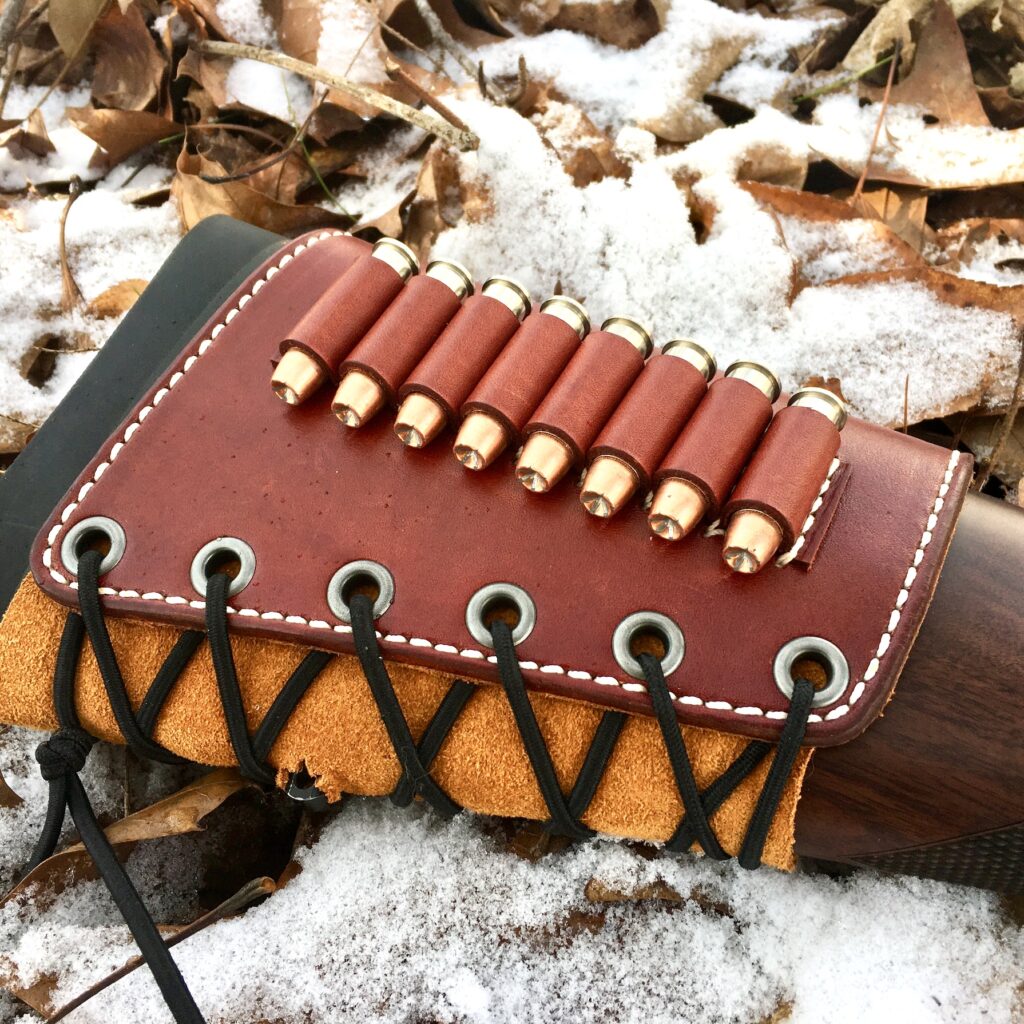
The other big complaint I see is that this method is slow. Not content to repeat that line without independently verifying, I did some work. I put in some dry practice with snap caps to see how quickly I could get this little levergun back in the fight. The fastest way I was able to come up with to reload the Henry was as follows:
-
- Fully remove the magazine tube and retain it with the left hand.
- Transition the rifle to the left hand. Now the left hand is holding the rifle by the forend, and retaining its magazine tube with the left ring and little fingers.
- From the 2x2x2 pouch, withdraw two rounds. Drop them one after the other into the magazine. Repeat two more times.
- Re-insert the magazine tube.
- Run the lever, and readdress the target as needed.
I ran 12 iterations of this technique against the timer. Times were measured shot to shot; I fired a shot, reloaded 6 rounds, and fired another shot. To be honest, I was surprised at how fast I was able to load this gun up and get it back in the fight. The average time to reload six rounds was 14.79 seconds (best time 13.13 seconds; worst time 16.06 seconds). Not crazy fast compared to an AR platform – actually not even crazy fast compared to reloading a revolver – but better than I expected. And these times might actually be better than side-loading lever-actions, butI didn’t have one to compare.
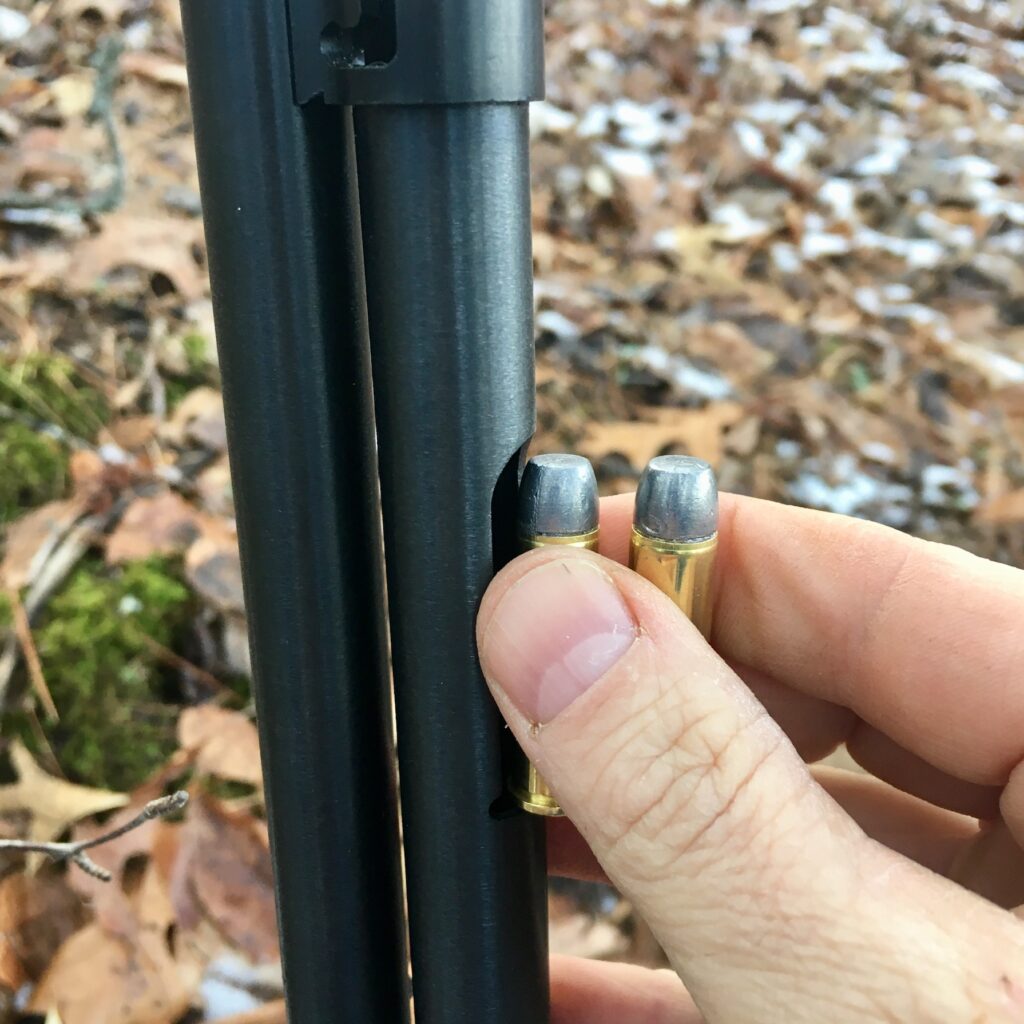
There’s a big caveat here, though: I knew the gun needed to be reloaded. In my timed drills I fired one round and immediately broke down my firing position. In real life, you’re probably going to fire that round, run the lever, and pull the trigger again before realizing you need to reload. I ran five iterations like this – running the lever and dropping the hammer on an empty chamber – and my times reflected it. The average was 17.38 seconds, fastest was 16.42, and slowest was 18.06.
One minor issue when loading rounds into the carbine two-at-a-time: if I held the cartridges too closely together, they would occasionally “rim lock.” That is, the rim of the cartridge falling into the magazine tube would hang up on the rim of the next cartridge in line. I thought about this a lot. You can probably prevent it by carefully stacking rounds into his 2x2x2 pouch so that the first cartridge in each pair is slightly lower than the other when the rounds are presented. Again, this requires careful cartridge setup, and could potentially be fouled while retrieving cartridges in a hurry. it also relies on the cartridges not shifting during wear. I think the surer method is to be aware of this while reloading and back the second cartridge off a tiny bit, creating a slight gap while dropping rounds into the tube.
Here’s my take: First, needing to reload this carbine is incredibly unlikely. If you do need to reload, though, it isn’t as slow as it’s made out to be. The biggest problem I see is that removing the magazine tube to reload takes the gun out of action. Until that magazine tube is back in the gun, the rifle is a single-shot. That’s also true of removing a magazine from an AR or a pistol, but getting the tube back in the Henry is a bit trickier. That being said, the odds of that happening are incredibly, vanishingly small. I’d probably work on my transition drill before I devoted much time to practicing reloading. And I’d probably work on accurate first-round hits before I worried about either.
Emergency Reloading the Chamber
I did find it possible to reload the chamber directly, via the ejection port, though the method seems to be less forgiving of imperfect technique. On my first several tries results were mixed. Sometimes the round would feed perfectly; at other times it would bind up on the elevator, requiring some “jiggling” of the lever to free it. I identified a couple of tips that might make this easier. I have only tried these in the Henry, so be sure to test them in your own gun.
First, I enjoyed massively better results if the muzzle was angled slightly downward. Keeping the gun level – or worse, tilting it slightly muzzle up – was a recipe for getting the rim of the cartridge caught between the rear of the elevator and the top of the receiver. Just a slight downward angle helped the cartridge fall to its home, all the way forward on the elevator.
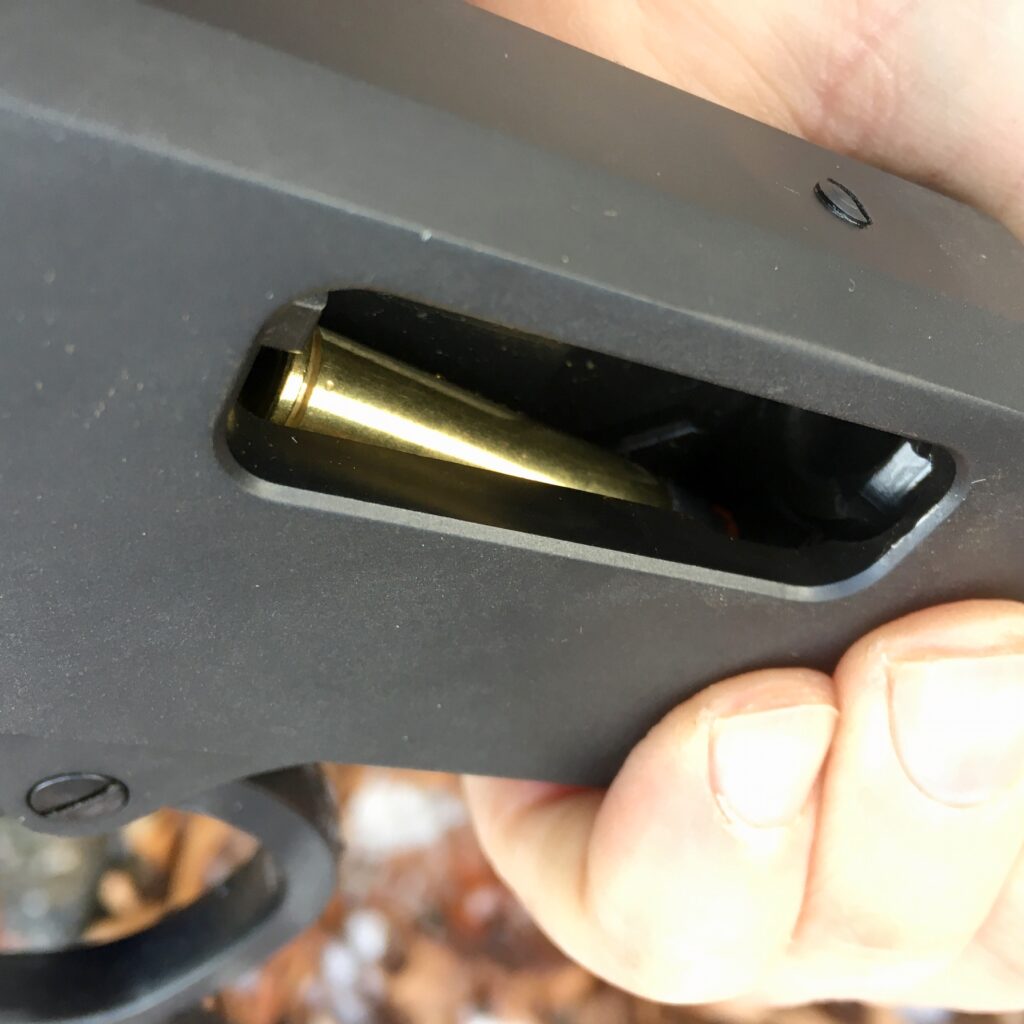
Next, I found that results were better when the the gun was not tilted side-to-side. Keeping the receiver of the gun straight up and down on its left/right axis again helped the cartridge find its place on the elevator. I ran a few iterations of this against the clock to see how quickly I could get a round back into the gun.
Reloading the chamber directly is where the Diamond D Butt Cuff really began to shine. It permitted the easy grasp of a single cartridge (without risk of loosening another) and placed it on the correct side of the gun for me. I really, really like this product, and you can expect a full review of it and the Diamond D sling very soon.
Ready Condition for the Lever Action
What is “ready condition” with a lever-action rifle? I thought about this question a lot. If you store it with a round in the chamber you have the possible benefit of having one more round on board (more on that in a second). You also have the gun in a more ready condition; all you have to do is thumb back the hammer and you’re ready to go. This may be considered by some to be a less-safe condition in which to store the rifle, so let’s look at the alternative.
The alternative is to store in something akin to “cruiser ready“: tube full, chamber empty. When you pick up the carbine because of the proverbial “bump in the night,” you run the lever and then… Well, and then you’re standing there with the hammer back over a round in the chamber. At some point you’re going to want to lower that hammer. If you do it shortly after the “bump” that got you up, you’re going to have to do it with shaky hands because of the adrenaline dump you got when you snapped awake.
I feel that storage with a round in the chamber is the way to go, at least for me. I’ll be honest – I don’t see a whole lot of benefit to storing the gun with the chamber empty. Someone pointed out this might be preferable if you had kids in the house. Were there a child about my home to whom a levergun with the a round in the chamber presented a danger, I don’t think the danger would be alleviated by leaving the chamber empty. Someone can correct me if I’m wrong, but simply leaving the chamber empty doesn’t render the gun “safe.” I also freely admit that there may be circumstances that I am failing to imagine where Condition 3 may be useful.
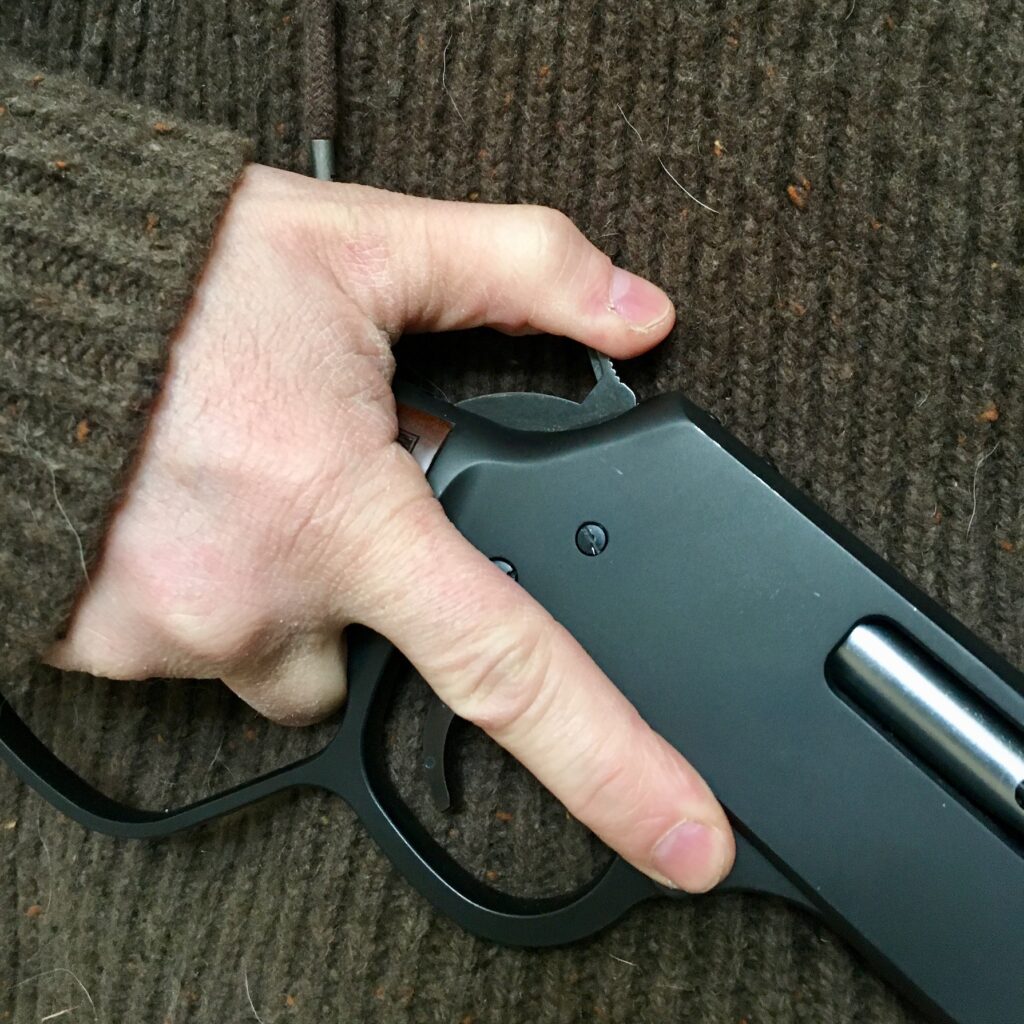
I also think “round in the chamber, thumb on the hammer” is the way to go if you’re – for whatever reason – moving or standing guard with this rifle. The hammer can be thumbed back on the way up. Getting it up and into action for that first shot is actually not much slower than just about much anything else. That being said, you are you alone are responsible for safe storage and handling of your firearms.
The Big Boy Steel Carbine can be topped off to accommodate seven plus one instead of just seven. However, doing so requires loading a round into the chamber before manipulating the magazine tube. This places your hands very near the muzzle, with a round in the chamber. Although I know “all guns are always loaded” this is an objectively more dangerous condition than manipulating the magazine tube with an empty chamber. If you do top off this carbine or one like it – I’m not recommending the practice, just saying if you do – keep this in mind and ALWAYS make sure the hammer is lowered before manipulating the magazine tube.
When it comes to getting the gun into action quickly do we get two-handed benefit? We sure do.
One-Handed Operation
Operating your long gun with only one hand is not something that is likely to happen to any of us. It does happen, though; FBI Agent Ed Mireles is maybe the most prolific, modern example of this. I wanted to see if the lever-gun could be run with one arm. As it happens, it’s very possible to run the Henry with one arm, simply by clasping the buttstock between your upper arm and torso. The Diamond D Butt Cuff really shines here, too, by helping to secure the buttstock into place. I didn’t try reloading one-handed. I’m certain it is possible, but I’m equally certain it would be a time-consuming process.
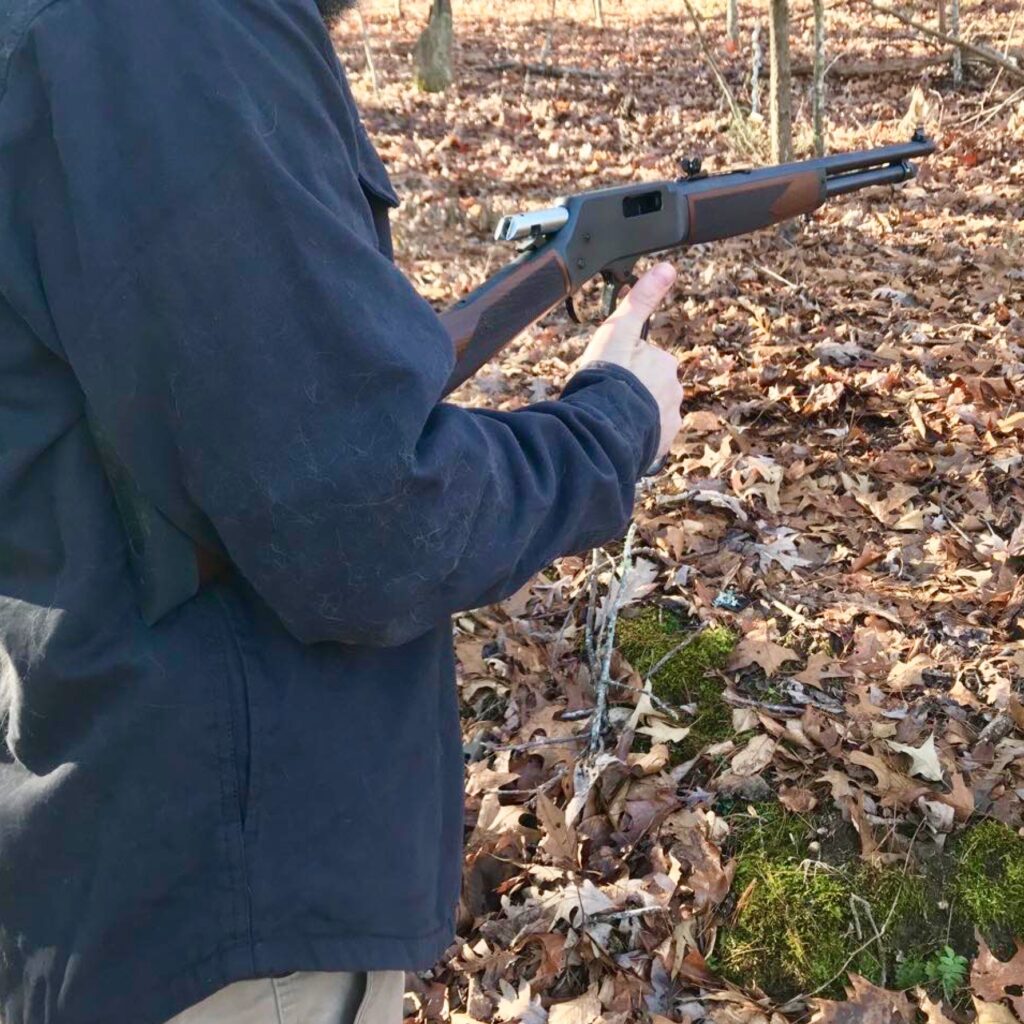
Do we get two-handed benefit here? Yes, and them some. I tried it side-by-side with my BCM Recce-14. The BCM weighs 6.0 pounds naked, and a loaded mag weighs almost a pound. Add a couple ounces for a sling, a few more for an optic and irons, and a couple more for a light, and I’m sure we’re close to 7.5 pounds. Which honestly isn’t that far off from the Henry’s 6.59 lb base weight, plus butt cuff, sling, and ammo. Still, the Henry felt easier to hold at the shoulder, longer. Maybe the weight is more evenly distributed; with its very light buttstock and aluminum receiver the AR places a lot of weight forward. Not sure, but bottom line: yes, two-hand benefit in regards to one-handed operation!
Sights & Lights
I also want to address the ability to put a light on the gun. While I don’t run a light on my carry handgun, I insist on one for my home defense gun. The lack of a provision for light-mounting is vexatious to me. So, I did some looking around online. Turns out I could probably make it work for under $20, plus whatever light I wanted to run. There are all sorts of little rail-section mounts that would clamp to the barrel or (preferably) the magazine tube.
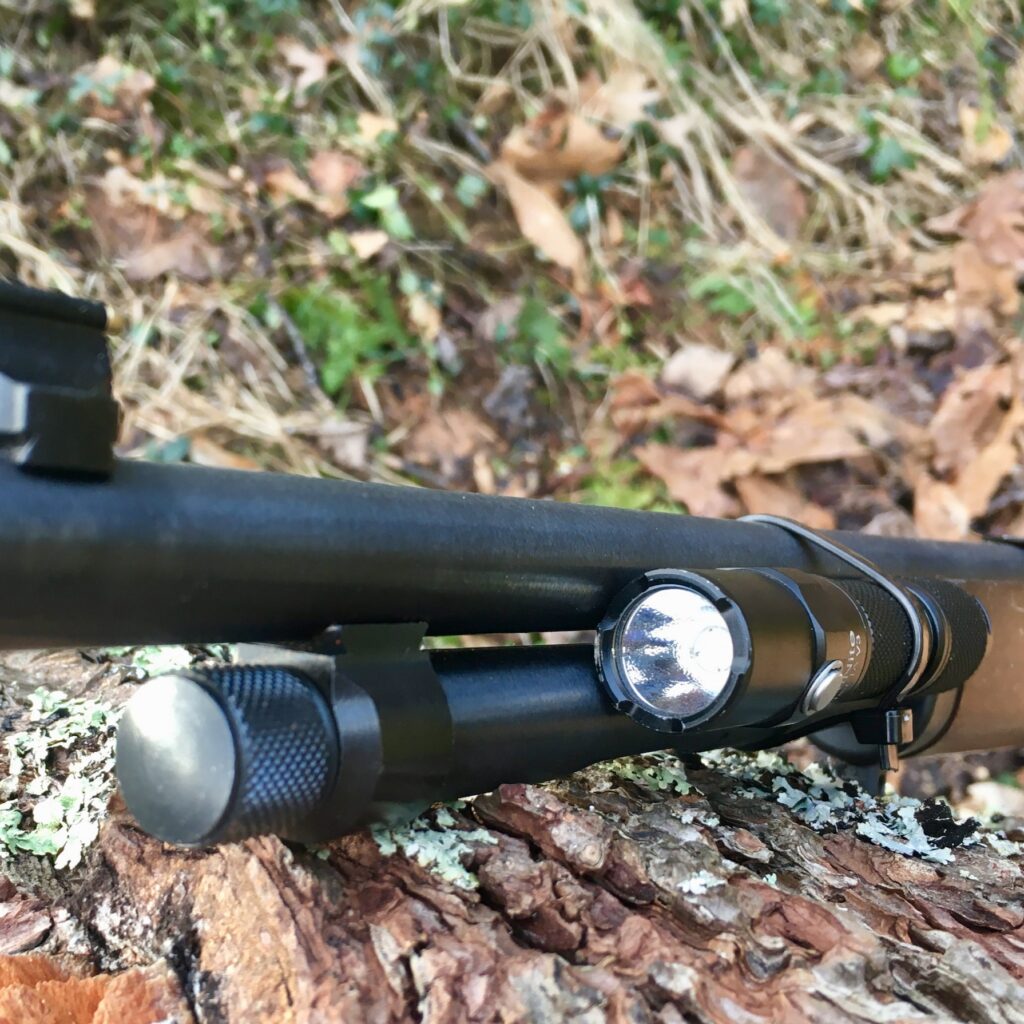
I went cheap. I took a pretty good flashlight with a tail switch and zip-tied it on. Now, that’s probably not doing much for accuracy, but it’s not like this is a free-floated barrel, anyway. This seemed to work well, a solid light-mounting solution would definitely see this gun replace my shotty as the home-defense long gun of choice. And, the newly-introduced “X” Series from Henry does have a light-mounting capability. If you want to see a review of that gun, let us and (maybe more importantly) Henry know!
The Bottom Line
Does the Henry Big Boy Steel Carbine specifically – and lever-action rifles generally – give us “two-hand weapon” benefits? Trick question! The answer is both “yes” and “no” but the real question should be, “does the carbine give us the desired two-hand weapon benefits?” At the risk of being a parrot I’m going to quote Pat Rogers: “mission drives the gear train.”
In this case my mission is defending home and hearth. Does the gear (the Henry Big Boy Steel Carbine) answer the mission? I contend it does. It provides excellent ergonomics. It’s short, lightweight, and easy-handling. It shoulders easily and is right at home with the “snap shot.” It’s much easier to shoot well than a handgun, and is, very possibly, much less intimidating to your family members should they have to employ it than a “real” rifle. Does it reload like an AR or provide AR ballistics? Nope, but again, does your mission require it to? That’s up to you – you have to write your own OPORD just like I have to write mine. For me the Henry Big Boy Steel Carbine will do nicely.
There’s one other thing that I’ve purposely avoided, but as I close out, I can’t leave it alone. No doubt every other writer of the modern era has mentioned this, but maybe for good reason.

Take a look at those two carbines. If you have to use a firearm in self-defense, the encounter doesn’t end when the brass hits your hardwood. It will very likely end with the strike of a gavel. Take a look at that photo. I’m not going to give you the answer, just ask the question: which would you rather the prosecutor wave around as he or she speculates about your motives, intentions, and attitudes? That shouldn’t be your sole determining criteria, but it should probably be one of them.
Oh wait. . . there’s one more thing. Last one – I promise:
The Ammo Thing
Interchangeability of ammunition is an undeniable allure of pistol-caliber carbines. Nowhere is this idea more appealing than PCCs chambered for revolver cartridges‡. I’ll admit that the concept is one that I can really sink my teeth into. It makes me start planning imaginary pack-mule trips into the canyon country of the southwest. It also makes the think of a modern incantation of that; I know more than one retired military friend who lives in an RV full-time. In a situation like that a revolver/levergun combo that could share ammo would be widely legal, versatile, and in the right hands, incredibly effective.
And then I really get to thinking about it, and while the ammo thing looks good on paper, I’m not so convinced of its true practicality. The longer barrel of the Henry is right at home with the most powerful .357 Magnum ammunition. Due to recoil, though, this isn’t the ammo I’d want to carry in a revolver. I also wouldn’t want to take carry ammunition that’s optimized for the handgun and stuff it in the Henry. Such ammo is designed to work within a given velocity window, and it would exceed its intended velocity from a carbine. This would require loads tailored to each firearm rather than a common one that could be shared.

Situations like living in an RV are growing more common, but they still aren’t all that common. Most of us have houses or apartments, and a storing ammo for a couple calibers isn’t that big a deal. As much as I see the appeal of two guns that eat the same ammo, it’s not really any more practical than any other long gun/handgun combo. To get maximum versatility out of the revolver/levergun combo would require a specific load or two for each gun. While the “ammo thing” is neat and would certainly be beneficial in a lot of imaginary situations, it’s probably not going to impact your real life that much.
Ok, now I’m finished for real!
†To be clear I’m having a little fun here but I’m not denigrating Colonel Cooper, nor am I overlooking his tremendous contributions to the worlds of handgunning or riflery. We all owe him a deep debt of gratitude, but we also owe it to ourselves to acknowledge that he was just as mortal as the rest of us. In the article I cited the Colonel said a lot of things that we’d be prone to be bemused by these days, more so perhaps if we didn’t know who said them. These statements don’t make him any less of a man, nor render his contributions any less significant. They do, however, illustrate that we are all fallible, and all, to some degree, products of our time and place. Food for thought.
‡Ok, that’s completely, 100% false. Even more appealing is a long gun and a handgun that take the same magazines.

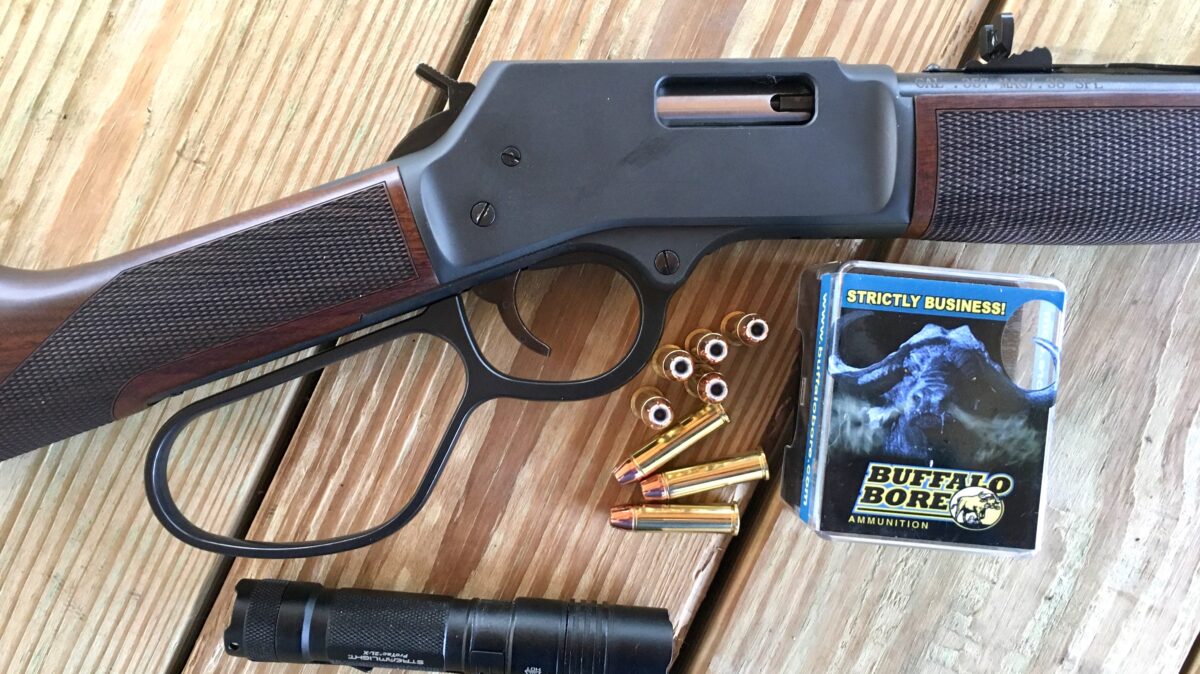
Just wanted to thank y’all for turning comments on. As for this gun, it is the next on my list. Has been for a few years. I plan to opt for the longer barrel and big loop.
Grant Cunningham dislikes slings on a perimeter-defense rifle, since the sling can snag other weapons with the rifle, when retrieved fast in an emergency. I have been reading his book on the topic of homestead defense with a rifle.
You seem to like a sling, as do I. Would make a good post for you and Grant to debate the merits and demerits of slings.
Great thoughts and a fair and balanced review as usual, Justin. I continue to really love my Henry .357 carbine – it’s fun to shoot, and offers plenty of practicality, if you accept it for what it is rather than expecting it to be something it isn’t. There’s certainly still a place for a light and nimble weapon capable of delivering a powerful payload at short-medium distance, and I believe there always will be. I also love that super-smooth Henry action and like you, have found the tube loading to be no big deal at all, with a minimum of practice.
I think it’s also a valuable observation that you point out – while the interchangeability of ammo between a carbine and a pistol is appealing, what often seems to get overlooked is the difference in optimal ammo for two different platforms. Still, I think the appeal lies in knowing that if it comes down to it, both guns will run that same ammo, even if the particular load in question isn’t ideal in both.
“….We all owe him a deep debt of gratitude, but we also owe it to ourselves to acknowledge that he was just as mortal as the rest of us.”
Indeed. While Cooper was certainly a visionary, he was not a god who’s every word should be seen as gospel. He could also at times be dogmatic and excessively black-and-white in his thinking…..kind of like most mortals.
Keep up the great work! I always look forward to seeing what comes next on this blog.
Also, for anyone interested in mounting a light on a lever gun, check out this mount from Hill People Gear:
https://www.hillpeoplegear.com/Products/CategoryID/8/ProductID/135
Your reference to the difficulty in finding a bullet which is optimal in both the rifle and the revolver is mostly dependent on barrel length of the revolver.
A 2 inch barreled revolver will have great difficulty in finding rounds which are optimal in both platforms. I would take time and look at the various rounds loaded with Barns all-copper bullets.
A 6 inch barrel (or greater) revolver barrel will have an easy time finding rounds which behave well in both platforms.
A 4 inch barreled revolver is difficult, but loads can be found which are optimal for game or defense in both platforms. If one is willing to pay $1+/round, there are a number of quality rounds which perform well in both a 4 inch revolver and a rifle or carbine. I’m most excited about offerings from Double Tap.
For me, if I can get 1350 fps or more out of a revolver, it is worth shooting the .357 load and it will be decent enough in both the rifle and revolver. If I can’t get that velocity out of a round, I would rather use a .38 in the revolver because I would rather have the faster follow up shots and ejection.
I found this worth my time. You might too:
https://www.ballisticstudies.com/Knowledgebase/.357+Magnum.html
Nice! Hi Mike from Austria!
I carry the Henry Big Boy 44mag ( 44 Special, because my GP-100 44 s does..).
This Gun is a real beautifully acurate 0-100 yards shooter, in every case and it is fast.
It sits between my Steyer Scout ( yes you can go 500-700yds..but you are normal slow/construction) and my FnH Scar-17 308lp, with Zeiss/ Loupoldi 890+ y..but
a bit to strange in the Woods.
The Henry works, is your live-partner and does not brekae down.
I like it. every day..next 100 years.
MIKE 🙂
I’ve got my hands on 6.5 Creedmore Henry and oh boy, it’s one of the best deer rifles I’ve ever used, especially since I’ve always had a soft spot for levers to begin with! One of the best manufacturers on the market in my opinion